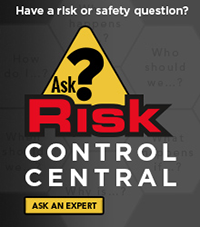Risk Alert for Senior Living Communities
Prevent disastrous lightning losses
With lightning packing up to 100 million volts of electricity, a lightning strike to an unprotected building can be disastrous. When lightning strikes a building, it will travel through the building and wiring until it finds the ground. This extra voltage can travel through electronic equipment and overload it—the type of damage that is often reported by senior living facilities insured by Church Mutual. The heat from the lightning and the heat generated from the resistance it encounters can quickly start a fire.
Create a lightning protection system
When you think about things that are most likely to be struck by lightning in a storm, a senior living facility probably isn’t top of mind. But fire and lightning losses account for nearly one-third of property claims filed by Church Mutual’s senior living facility customers.
- Almost 60 percent of lightning strikes result in either one or all of the following systems being knocked out of service at a senior living facility: fire alarm, security, call service or telephones.
To protect your facility from the frightening consequences of a lightning strike, consider the following:
- Lightning rod system – This system consists of rods at high points on the building connected to metal cables that run down the sides of the building to a point 2 feet to 10 feet below the ground. The lightning is intercepted and directed to the ground without causing damage to the building or its contents.
- Surge protectors – The Institute of Electrical and Electronics Engineers (IEEE) notes that this common form of protection for electronic equipment is widely utilized by both consumer and commercial users but should not be relied upon as the only defense against a lightning strike. Look for a plug-in protector with the Underwriters Laboratories (UL) rating label to ensure that it meets minimum protection requirements. Also consider that higher quality protectors will typically provide higher levels of protection, although they cost more to purchase.
- Unplug electronics – Even with surge protectors, take the extra step to unplug valuable and sensitive electronics, such as computers and sound systems, when not in use or before a storm begins.
- Protect signal lines – Protect wires that extend outside the building. This is an area commonly lacking proper protection as many alarm systems are tied into the telephone lines. Ensure that telephone, fax machine, dial-up and DSL modem lines are connected to plug-in surge protectors. When purchasing a surge protector, look for one with multiple ports to provide circuit protection for all your signal line equipment.
Find the right installer
Total building protection, including lightning rod systems, will require professional installation. Look for a certified contractor. Ask for an Underwriters Laboratories or Lightning Protection Institute certified contractor to install the lightning protection system.
Create a lightning protection system
-
Almost 60 percent of lightning strikes result in either one or all of the following systems being knocked out of service at a senior living facility: fire alarm, security, call service or telephones.
-
Lightning rod system – This system consists of rods at high points on the building connected to metal cables that run down the sides of the building to a point 2 feet to 10 feet below the ground. The lightning is intercepted and directed to the ground without causing damage to the building or its contents.
- Surge protectors – The Institute of Electrical and Electronics Engineers (IEEE) notes that this common form of protection for electronic equipment is widely utilized by both consumer and commercial users but should not be relied upon as the only defense against a lightning strike. Look for a plug-in protector with the Underwriters Laboratories (UL) rating label to ensure that it meets minimum protection requirements. Also consider that higher quality protectors will typically provide higher levels of protection, although they cost more to purchase.
-
Unplug electronics – Even with surge protectors, take the extra step to unplug valuable and sensitive electronics, such as computers and sound systems, when not in use or before a storm begins.
- Protect signal lines – Protect wires that extend outside the building. This is an area commonly lacking proper protection as many alarm systems are tied into the telephone lines. Ensure that telephone, fax machine, dial-up and DSL modem lines are connected to plug-in surge protectors. When purchasing a surge protector, look for one with multiple ports to provide circuit protection for all your signal line equipment.
Find the right installer
For a complete collection of the Risk Alert for Senior Living Communities series, click here.







